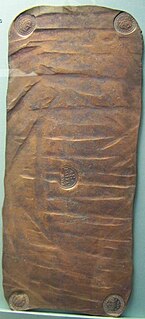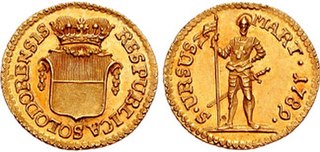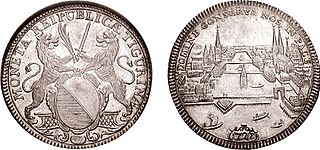The Thaler was the currency of the Electorate, later Kingdom of Hanover until 1857. Until 1834, it was equal to three quarters of a Conventionsthaler and was subdivided into 36 Mariengroschen, each of 8 Pfennig .
A currency, in the most specific sense is money in any form when in use or circulation as a medium of exchange, especially circulating banknotes and coins. A more general definition is that a currency is a system of money in common use, especially for people in a nation. Under this definition, US dollars (US$), pounds sterling (£), Australian dollars (A$), European euros (€), Russian rubles (₽) and Indian Rupees (₹) are examples of currencies. These various currencies are recognized as stores of value and are traded between nations in foreign exchange markets, which determine the relative values of the different currencies. Currencies in this sense are defined by governments, and each type has limited boundaries of acceptance.

The Prince-electors of the Holy Roman Empire, or Electors for short, were the members of the electoral college that elected the Holy Roman Emperor.

The Kingdom of Hanover was established in October 1814 by the Congress of Vienna, with the restoration of George III to his Hanoverian territories after the Napoleonic era. It succeeded the former Electorate of Brunswick-Lüneburg, and joined 38 other sovereign states in the German Confederation in June 1815. The kingdom was ruled by the House of Hanover, a cadet branch of the House of Welf, in personal union with the United Kingdom of Great Britain and Ireland until 1837. Since its monarch resided in London, a viceroy handled the administration of the Kingdom of Hanover.
Between 1807 and 1813, the Westphalian Thaler (equal to the Hannovarian Thaler) and the Westphalian Frank circulated in Hannover.
The Thaler was a currency of the Kingdom of Westphalia between 1807 and 1813. From 1808, it circulated alongside the Frank. The Thaler was equal to those of the preceding states, including the Hannovarian Thaler. It was subdivided into 36 Mariengroschen, each of 8 Pfennig.
The Frank was a currency of the Kingdom of Westphalia between 1808 and 1813. It circulated alongside the Thaler, was equal to the French franc, and was subdivided into 100 Centimen.
In 1834, the Thaler was slightly reduced in silver content to make it equal to the Prussian Thaler. The Thaler was replaced at par in 1857 by the Hannovarian Vereinsthaler.

Silver is a chemical element with the symbol Ag and atomic number 47. A soft, white, lustrous transition metal, it exhibits the highest electrical conductivity, thermal conductivity, and reflectivity of any metal. The metal is found in the Earth's crust in the pure, free elemental form, as an alloy with gold and other metals, and in minerals such as argentite and chlorargyrite. Most silver is produced as a byproduct of copper, gold, lead, and zinc refining.
The Thaler was the currency of Prussia until 1857. From 1750, it was distinct from north German Reichsthaler unit of account in that it contained 1⁄14 of a Cologne mark of silver, rather than 1⁄12, and was minted as a coin. This change was implemented by Johann Philipp Graumann and the system of 14 thaler to the mark was known as the Graumannscher Fuß.











